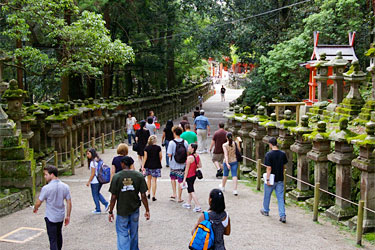Learn More About PUC
Students Experience Japan
By Lainey S. Cronk on July 1, 2010
Share this

It's a June day in Atami, Japan, and a group of students and professors are getting a new lodging experience at a ryokan, a traditional Japanese inn where they sleep on mats on the floor, wear yukata (casual summer kimonos), and eat traditional food.
While memorable, the ryokan experience is just one of many adventures on a ten-day trip introducing these 15 Pacific Union College students and three professors to Japan — modern and traditional — for two classes, an Asian seminar history class and a political science class on U.S. foreign relations.
History professors Ileana Douglas and Hilary Elmendorf led the trip and taught the classes, and biology professor Aimee Wyrick went along just for the experience. The students met for several class periods on campus before departing; while on the trip, the learning took place almost entirely on the go, with some meetings or debriefings on buses between tour sites. Each student journaled the experience and chose a topic for a follow-up research paper.
They started in Tokyo, exploring three shrines and a blend of modern and traditional culture. Then they visited ancient capitals Kamakura and Kyoto, spent time in a national park where they could view Mt. Fuji (and eat eggs that were black from being boiled in the sulfur springs), and traveled to Nara, Osaka, and Hiroshima. One notable stop was the Yasukuni museum and shrine, honoring war heroes — a controversial site due to including war criminals among those enshrined. Student Tyler Jones, who was enrolled in the political science course, chose the shrine as the topic of his research paper but admits it will be a difficult one!
Looking at the trip in general, Jones felt that the time in Kyoto was a high point — both for the "old buildings and the new buildings mixed together" and for the hospitality he experienced. He recounts walking with a classmate and stopping to watch a man cooking. When the man explained that it was breakfast they said it looked good and then continued on their way. "Moments later we hear behind us a man saying 'Hello, hello.' He ran up to us and handed us six of the fresh dumpling things that he and his shop had been cooking for breakfast."
For many, the visit to Nara, another ancient capital, was a highlight. Experiencing the temple and park, Douglas says, was so much more powerful than any photo could portray. "The architecture, the flowers, the mountains behind — it was absolutely magnificent." As with each stop, it was a learning opportunity as the teachers helped students connect history, religion and culture, including influences from various other countries.
Douglas has been on many educational tours with students in the past, though the Japan trip was a first for her. She agreed that the many elements of the trip meshed perfectly. "It was absolutely a growing experience for students and for teachers," she says. "The students kept saying, 'I'm learning so much!' … and in the meantime they were having fun as well, experiencing the culture — they asked questions, they took pictures, they loved the food, they learned a lot. It was a good combination of learning and fun and traveling."
Elmendorf, who used to live in Japan on a research fellowship, enjoyed watching the students experience a culture that was familiar to her. "The students were outstanding," she says. "It was very fun for me to see a country that I love, to see [the students] interact with the culture." And for Wyrick, who hasn't done international travel before, it was a great first experience. "In total, I think the connections that we made as a group (teachers and students) was the best outcome of the trip," she says. "We had a chance to interact on a different level and I really cherish that."
The PUC history department leads a history tour every other summer; the next one, in 2012, will explore "The Atlantic World" with half the trip in the Washington, D.C., area and the second half in England.
Latest News
First Set of PUC’s North Coast Nursing Students Graduate
By Ally Romanes on December 23, 2025
Two Tonge Grants Awarded to M.A. in Communication and Aviation Program
By Marina Maher on December 22, 2025
PUC’s College Days Creates Lasting Connections
By Ally Romanes on December 18, 2025
